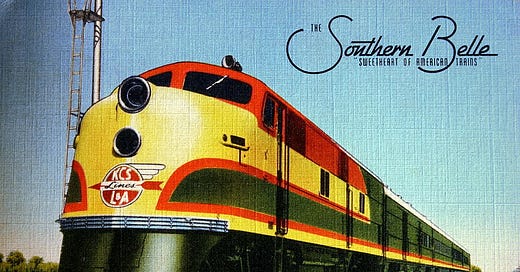
The Kansas City Southern Railroad is part of today’s CPKC, which stands for Canadian Pacific Kansas City. If someone had told me a couple of dozen years ago that KCS would become a viable part of a predominantly Canada-based railroad enterprise, I’d have said: “No way!” Via the assumption of KCS by CP, this now international agglomeration operates in Canada, Mexico and the United States.
Enough about CPKC. Let’s get back to talking trains and KCS.
A Capsule History
The Kansas City Southern Railway began life as the Kansas City Suburban Belt Railway in 1887 in the town in Missouri bearing the same name. Through acquisition of other lines, the railroad became the Kansas City, Pittsburg & Gulf Railroad Company on Sept. 11, 1897, creating a through route between Kansas City and the Texas Gulf Coast city of Port Arthur. In 1900, the company adopted its last name: the Kansas City Southern which, by the way, was officially retired on Apr. 14, 2023.
Furthermore, in 1939, the KCS folded into its operations another Midwest-based railway, this time the Louisiana & Arkansas Railway, an important addition. In the U.S., in the meantime, the company conducted its operations in Alabama, Arkansas, Illinois, Kansas, Louisiana, Mississippi, Missouri, Oklahoma, Tennessee and Texas — 10 states in all.
In the waning days of the 20th century, KCS was one of five total wholly American Class I rail properties. Kansas City Southern was joined by, in alphabetical order: Burlington Northern & Santa Fe; CSX; Norfolk Southern; and Union Pacific.
Today’s Super Six if you like, which also includes Canadian National and Canadian Pacific Kansas City added to that mix, incidentally, all grew to the sizes they are on account of expansion. And, for KCS back in the day, it was more of the same.
Previously in 1993, Kansas City Southern went through an expansion of its own when it acquired MidSouth(i), which, effectively, doubled its mileage. Then in 1995, KCS and Illinois Central entertained the idea of combining their railroad assets, but later backed out of the deal. Industry analysts speculated that the deal was called off because IC’s stock price fell by more than $3 per share after the merger announcement was made. Others suggested that parent KCS Industries (KCSI) had a change of heart, preferring to hold onto its railroad instead. Then again, with the tectonic shifting taking place throughout the industry then (see: Merger Madness under the Reinvention subhead in “1980-2000: A Most Exciting Time!”), perhaps KCS thought an offer from Union Pacific or Burlington Northern would be in the offing should either of those giants fail to receive Surface Transportation Board approval of the Santa Fe acquisition; taking sort of a “wait and see” approach.[1]
Meanwhile, on Jul. 1, 1996, KCSI was chosen as operator of the 47.6-mile-long Panama Railroad, a concession by the Panamanian government.
The Gateway Western Railroad was added to KCS’ stable of railroad properties on May 5, 1997. Through the Gateway Western, Kansas City Southern’s network of track grew by 461 miles in western Illinois and western Missouri and in eastern Kansas. KCS track route-miles totaled roughly 4,000 in all within the United States.
Kansas City Southern is perhaps best known for its Southern Belle passenger train which was in service from 1940 to 1969, and operated between Kansas City, Missouri and New Orleans, Louisiana. The train was made famous no doubt on account of its eye-catching red, yellow and brown paint scheme.
Notes
Trains, Jan. 1995, pp. 22, 24
(i) The company was previously led by George W. Edwards who was instrumental in bringing the MidSouth properties into the KCS fold.
Updated: Jul. 6, 2025 at 4:28 p.m. PDT.
All material copyrighted 2025, Alan Kandel. All Rights Reserved.



